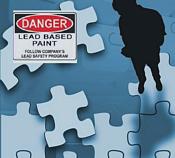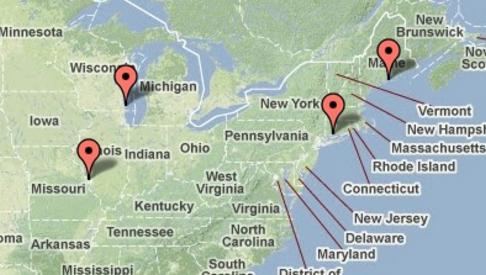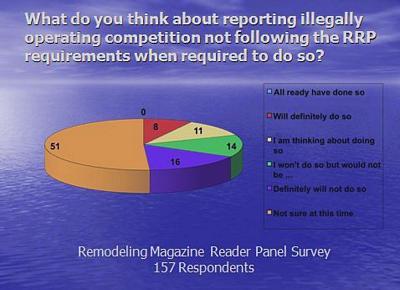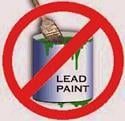Don’t Be Mislead By the Vote to Cut Off RRP Enforcement Funding
On July 13, 2011 the House Appropriations Committee voted to cut off funding for enforcement of the RRP Rule until a reliable test kit is recognized by EPA. The amendment was included in the House Appropriations Bill by Representative Denny Rehberg (R-Mont.).
Note: For clarification, a “reliable test kit” means a test kit that would be able to determine if a painted or coated surface contains lead equal to or in excess of 1.0 milligrams per square centimeter (mg/cm2) or 0.5% by weight. The current test kits will reliably indicate whether the surface contains any lead or not, but do not measure the amount of lead.
Unfortunately, as a result of the vote many renovators are now assuming that they no longer need to comply with the RRP rule and do not have to use lead-safe work practices on pre-1978 target housing and child occupied facilities. If you are a renovator making that assumption it would be a big mistake that could cost you big time. Let me explain.
First, any cut or stoppage of enforcement would only apply to states where EPA administers and enforces the rule. It would not have any effect at all in those states that have assumed administration and enforcement of the rule from EPA.
Regarding the vote, it is an amendment added to a proposed bill which must go before the full House and Senate for approval. Even if approved in the House and Senate it must then be sent to the president for his signature before passing. The president signing it, at least in my opinion, is not very likely. Obama had a lot to do with why the rule exists to begin with.
Even if the amendment to the rule were to go into effect, all it would do is take away the money EPA has to fund enforcement. It would not eliminate the rule. If and when a reliable test kit were to be eventually recognized by EPA, and finally made it to the marketplace, enforcement funding would then become available again.
EPA can eventually get you anyway:  Keep in mind that the rule requires that renovators keep all required documentation and that it be available for EPA audit for 3 years. That means EPA can retroactively enforce the rule 3 years back. If and when enforcement happens, all EPA needs to do is ask to see a renovators documentation to determine whether all the regulated work performed during that 3 year period was properly documented, met the rule’s requirements and that property owners and/or tenants received the required Renovate Right pamphlet, any lead testing results documentation as well as a copy of the required renovation checklist. Remember, the fine is up to $37,500 per violation per day!
Keep in mind that the rule requires that renovators keep all required documentation and that it be available for EPA audit for 3 years. That means EPA can retroactively enforce the rule 3 years back. If and when enforcement happens, all EPA needs to do is ask to see a renovators documentation to determine whether all the regulated work performed during that 3 year period was properly documented, met the rule’s requirements and that property owners and/or tenants received the required Renovate Right pamphlet, any lead testing results documentation as well as a copy of the required renovation checklist. Remember, the fine is up to $37,500 per violation per day!
Property Owners, Tenants and Parents can get you anytime:
Also, keep in mind that even if EPA can’t or doesn’t enforce the rule, your customers, their neighbors and the parents of children attending a child occupied facility can still sue you for not following the law. And, as a business, if accused, you are considered guilty until you prove you and your business is innocent at your own expense, money you cannot recoup in court.
 Plus, one fact that many business owners may not be aware of is that, under the rule, the business owner can be held civilly liable for violating the rule. Don’t assume you are personally protected just because of the legal status of your business.
Plus, one fact that many business owners may not be aware of is that, under the rule, the business owner can be held civilly liable for violating the rule. Don’t assume you are personally protected just because of the legal status of your business.

 Looking for accurate information about the EPA RRP rule?
Looking for accurate information about the EPA RRP rule? 
 In my opinion this tool will be helpful for those renovators following RRP requirements for a variety of reasons. For example, it will help level the playing field for legally operating businesses if the awareness of audits persuades illegal businesses to change their ways. Because the tool allows those reporting audits to include details about the audit, renovators will learn what to expect and how to better handle an audit if one happens to them. Also, for those who like to help their peers, being able to submit a report that is informative and shares constructive advice becomes a win-win for both the reporter and those who read the reports.
In my opinion this tool will be helpful for those renovators following RRP requirements for a variety of reasons. For example, it will help level the playing field for legally operating businesses if the awareness of audits persuades illegal businesses to change their ways. Because the tool allows those reporting audits to include details about the audit, renovators will learn what to expect and how to better handle an audit if one happens to them. Also, for those who like to help their peers, being able to submit a report that is informative and shares constructive advice becomes a win-win for both the reporter and those who read the reports. On the other hand, the tool will not likely be helpful to those who knowingly and willfully violate the rule. Knowing where EPA, OSHA and/or states agencies are doing inspections or audits won’t be much help in hiding from an inspector. As we have seen, job site inspections are not likely. Removing magnetic signs or parking their trucks out of view won’t protect violators from an audit. The required documentation gives the authorities the ability to retroactively inspect work practices as well as compliance with owner and occupant pre-notification requirements. Because the EPA rule dictates that all required documentation be kept for three years, one visit to a renovator’s office by EPA can uncover enough violations and justify enough fines to put an illegal business out of business. The Massachusetts requirement for storing documents is 10 years, giving illegal businesses in that state much more to be worried about.
On the other hand, the tool will not likely be helpful to those who knowingly and willfully violate the rule. Knowing where EPA, OSHA and/or states agencies are doing inspections or audits won’t be much help in hiding from an inspector. As we have seen, job site inspections are not likely. Removing magnetic signs or parking their trucks out of view won’t protect violators from an audit. The required documentation gives the authorities the ability to retroactively inspect work practices as well as compliance with owner and occupant pre-notification requirements. Because the EPA rule dictates that all required documentation be kept for three years, one visit to a renovator’s office by EPA can uncover enough violations and justify enough fines to put an illegal business out of business. The Massachusetts requirement for storing documents is 10 years, giving illegal businesses in that state much more to be worried about.
 A
A  Perhaps industry trade associations can take advantage of this executive order to get EPA to rethink the current RRP rule. To protect the interests of renovators, at a minimum, the RRP Rule or any proposed amendments should reflect real scientific facts about EBLL’s caused by RRP activities and address the economic challenges currently being experienced by compliant businesses that have been complaining about illegal and unfair completion due to the lack of enforcement of the RRP Rule by EPA.
Perhaps industry trade associations can take advantage of this executive order to get EPA to rethink the current RRP rule. To protect the interests of renovators, at a minimum, the RRP Rule or any proposed amendments should reflect real scientific facts about EBLL’s caused by RRP activities and address the economic challenges currently being experienced by compliant businesses that have been complaining about illegal and unfair completion due to the lack of enforcement of the RRP Rule by EPA. 

 Banks have started to figure out that the costs and liabilities related to the EPA RRP rule can dramatically increase their costs and risks. Banks that own foreclosed properties have quickly discovered the additional costs they will incur when repairing and or renovating these properties just so they can sell them. Under the RRP rule, landlords need to become certified firms and use certified renovators when working on their properties. Banks who take possession of pre-1978 properties need to do the same and or only hire certified firms to perform the work for them. As a result of the RRP rule, many pre-1978 foreclosed homes are now worth less than they were valued prior to the April 22, 2010 date the new EPA RRP rule took effect.
Banks have started to figure out that the costs and liabilities related to the EPA RRP rule can dramatically increase their costs and risks. Banks that own foreclosed properties have quickly discovered the additional costs they will incur when repairing and or renovating these properties just so they can sell them. Under the RRP rule, landlords need to become certified firms and use certified renovators when working on their properties. Banks who take possession of pre-1978 properties need to do the same and or only hire certified firms to perform the work for them. As a result of the RRP rule, many pre-1978 foreclosed homes are now worth less than they were valued prior to the April 22, 2010 date the new EPA RRP rule took effect.  Banks are also more likely to end up with additional foreclosed properties due to the RRP rule. For struggling pre-1978 homeowners and investors, perhaps already upside-down on their mortgages, the additional repair and maintenance costs related to the EPA RRP rule may be just one more reason to justify letting their properties go to foreclosure. Finding out about the potential additional drop in equity value in the property due to the EPA RRP rule may become a second reason to let upside down properties go to foreclosure.
Banks are also more likely to end up with additional foreclosed properties due to the RRP rule. For struggling pre-1978 homeowners and investors, perhaps already upside-down on their mortgages, the additional repair and maintenance costs related to the EPA RRP rule may be just one more reason to justify letting their properties go to foreclosure. Finding out about the potential additional drop in equity value in the property due to the EPA RRP rule may become a second reason to let upside down properties go to foreclosure. As mentioned above, banks have already started to become aware of the EPA RRP rule due to foreclosures. They are also using this knowledge when considering loans. If loaning money to home buyers for purchases and or to property owners for renovations, banks will likely want to know if a pre-1978 property contains lead and if it does how it might affect the value of the home. A home needing significant repairs or maintenance after purchase will likely have a much lower value if the work will fall under the EPA RRP rule. Such scenarios might have a few different effects ranging from requiring more money down, higher interest rates, lower appraised value of the property as compared to the selling price and or ultimately denying to loan money on the property.
As mentioned above, banks have already started to become aware of the EPA RRP rule due to foreclosures. They are also using this knowledge when considering loans. If loaning money to home buyers for purchases and or to property owners for renovations, banks will likely want to know if a pre-1978 property contains lead and if it does how it might affect the value of the home. A home needing significant repairs or maintenance after purchase will likely have a much lower value if the work will fall under the EPA RRP rule. Such scenarios might have a few different effects ranging from requiring more money down, higher interest rates, lower appraised value of the property as compared to the selling price and or ultimately denying to loan money on the property.  Although every “legal” remodeler I have spoken to expresses concerns about illegal competition doing their work in violation of the RRP rule, these remodelers are split about whether to report their illegal completion or not. At the Opening Session I presented on Thursday morning at the Remodeling Show I offered my point of view on this. I suggested that illegal contractors and the home owners who hire them are stealing business and money away from legal remodelers and their employees. I gave the example that if you or I steal a TV from someone and get caught, we must return the TV and suffer any consequences. If an illegal contractor or home owner steals a deck job from a legal contractor little or nothing is ever done and the home owner gets to keep the deck. How long will our industry and the trade associations that represent us tolerate this? Just like with illegal immigration, because our government does not enforce existing rules and laws on a consistent basis, illegal contractors operate with little fear of being caught and even if caught, have little fear of any consequences.
Although every “legal” remodeler I have spoken to expresses concerns about illegal competition doing their work in violation of the RRP rule, these remodelers are split about whether to report their illegal completion or not. At the Opening Session I presented on Thursday morning at the Remodeling Show I offered my point of view on this. I suggested that illegal contractors and the home owners who hire them are stealing business and money away from legal remodelers and their employees. I gave the example that if you or I steal a TV from someone and get caught, we must return the TV and suffer any consequences. If an illegal contractor or home owner steals a deck job from a legal contractor little or nothing is ever done and the home owner gets to keep the deck. How long will our industry and the trade associations that represent us tolerate this? Just like with illegal immigration, because our government does not enforce existing rules and laws on a consistent basis, illegal contractors operate with little fear of being caught and even if caught, have little fear of any consequences.
 As we all wait to see what happens with the economy and how long a real recovery will take, I predict that their ability to pay their mortgage and put food on the family table will persuade many remodeling business owners to take action and defend their ability to run honest businesses.
As we all wait to see what happens with the economy and how long a real recovery will take, I predict that their ability to pay their mortgage and put food on the family table will persuade many remodeling business owners to take action and defend their ability to run honest businesses. If home buyers aren’t aware of lead paint or the implications of buying a property that has or may have lead paint, a good home inspector may likely provide such knowledge.
If home buyers aren’t aware of lead paint or the implications of buying a property that has or may have lead paint, a good home inspector may likely provide such knowledge.  Home inspectors will help cause compliance with the EPA RRP rule in a few ways. First, they will likely make home buyers aware of the fact that if built before 1978, the home may likely contain lead paint. The only way to verify if lead paint is present is to do a lead test. Inspectors can suggest their clients ask the seller if the home has been tested and if it has to obtain a copy of the required lead inspection report. Next, if the home does have lead, or it hasn’t been tested, inspectors should inform the buyers that any renovations to the home would need to be done using lead-safe work practices. This will have two effects. The first would be to let the buyer know that lead-safe work practices are required should they be planning any renovations after purchasing the home. Second, and most critical, would be to verify that any recent renovations done at the home were done using lead-safe work practices and to verify this by making sure who ever did the work did it in compliance with the EPA RRP requirements. Again, requesting a copy of the
Home inspectors will help cause compliance with the EPA RRP rule in a few ways. First, they will likely make home buyers aware of the fact that if built before 1978, the home may likely contain lead paint. The only way to verify if lead paint is present is to do a lead test. Inspectors can suggest their clients ask the seller if the home has been tested and if it has to obtain a copy of the required lead inspection report. Next, if the home does have lead, or it hasn’t been tested, inspectors should inform the buyers that any renovations to the home would need to be done using lead-safe work practices. This will have two effects. The first would be to let the buyer know that lead-safe work practices are required should they be planning any renovations after purchasing the home. Second, and most critical, would be to verify that any recent renovations done at the home were done using lead-safe work practices and to verify this by making sure who ever did the work did it in compliance with the EPA RRP requirements. Again, requesting a copy of the  Additionally, if the work was done by the home owners themselves, or perhaps was done illegally by a non-complaint contractor, the only way to find out if the work may have contaminated the home with lead would be to have the home tested by a
Additionally, if the work was done by the home owners themselves, or perhaps was done illegally by a non-complaint contractor, the only way to find out if the work may have contaminated the home with lead would be to have the home tested by a 
 Home buyers, investors and realtors will likely drive awareness about lead and the new EPA RRP rule up. But, at the same time, such awareness will drive the values of pre-1978 properties down. If unaware of the additional considerations of risks, liability and costs related to the RRP, realtors will likely walk into a hornet’s nest.
Home buyers, investors and realtors will likely drive awareness about lead and the new EPA RRP rule up. But, at the same time, such awareness will drive the values of pre-1978 properties down. If unaware of the additional considerations of risks, liability and costs related to the RRP, realtors will likely walk into a hornet’s nest.  A buyer’s willingness to purchase a property that contains lead will definitely be effected as a result of the RRP rule. First, once word gets out, the health risks of lead paint and related liabilities will cause many buyers to bypass any consideration of pre-1978 properties. As the supply goes up, the prices of these properties will go down. Also, investors won’t like the added costs of owning such properties, particularly if the value of those properties is less likely to increase over time as compared to properties without lead. This too will lower property values to a point where the value of certain properties may only be in the land they sit on, less the cost to get rid of the original lead infused structure.
A buyer’s willingness to purchase a property that contains lead will definitely be effected as a result of the RRP rule. First, once word gets out, the health risks of lead paint and related liabilities will cause many buyers to bypass any consideration of pre-1978 properties. As the supply goes up, the prices of these properties will go down. Also, investors won’t like the added costs of owning such properties, particularly if the value of those properties is less likely to increase over time as compared to properties without lead. This too will lower property values to a point where the value of certain properties may only be in the land they sit on, less the cost to get rid of the original lead infused structure. As a side note, realtors as a whole are typically much more professional and proactive than contractors. The majority of them are also dues paying members of one single, well funded and very powerful trade association that represents their interests. I predict that once a good number of realtors catch wind of and understand how the RRP will affect their industry; their association will be working to modify the rule in their favor. This might be of benefit to renovators, but just as easily, it might not.
As a side note, realtors as a whole are typically much more professional and proactive than contractors. The majority of them are also dues paying members of one single, well funded and very powerful trade association that represents their interests. I predict that once a good number of realtors catch wind of and understand how the RRP will affect their industry; their association will be working to modify the rule in their favor. This might be of benefit to renovators, but just as easily, it might not. Many contractors seeking to comply with the new EPA RRP rule are reporting concerns and challenges about finding trade partners who are willing to operate in compliance. Many renovators have told me that their trade partners have flat out refused to get their businesses and workers certified. Others have said their trade partners have committed to do so but have been slow to get it done due to the related costs. This has become quite an opportunity for some trade partners who have become certified and are marketing their certifications and services to general contractors. Several are actually offering to sub-contract the set-up, containment, demo, clean-up, cleaning verification and all related and required documentation for general contractors.
Many contractors seeking to comply with the new EPA RRP rule are reporting concerns and challenges about finding trade partners who are willing to operate in compliance. Many renovators have told me that their trade partners have flat out refused to get their businesses and workers certified. Others have said their trade partners have committed to do so but have been slow to get it done due to the related costs. This has become quite an opportunity for some trade partners who have become certified and are marketing their certifications and services to general contractors. Several are actually offering to sub-contract the set-up, containment, demo, clean-up, cleaning verification and all related and required documentation for general contractors. Who will take care of the notification requirements and documentation of same before the job begins? Under the rule, either can do so, but the business under contract with the property owner must maintain the required documentation.
Who will take care of the notification requirements and documentation of same before the job begins? Under the rule, either can do so, but the business under contract with the property owner must maintain the required documentation. The first time a RRP fine is accessed for a violation the finger pointing will start, causing one or both businesses to get serious about certification and compliance. The first time a renovator is sued by a client or neighbor as a result of the actions of a trade partner, the tactics used by the lawyers will cause both businesses to have a new and different outlook on RRP compliance, insurance coverage amounts and indemnification clauses.
The first time a RRP fine is accessed for a violation the finger pointing will start, causing one or both businesses to get serious about certification and compliance. The first time a renovator is sued by a client or neighbor as a result of the actions of a trade partner, the tactics used by the lawyers will cause both businesses to have a new and different outlook on RRP compliance, insurance coverage amounts and indemnification clauses.  To confuse matters even further, under their definition of the difference between an employee and an independent contractor, the IRS says that a contractor cannot supervise the work or workers of a sub contractor. Doing so might result in the IRS labeling the sub contractor as an employee. If this were to happen it could trigger addition payroll taxes and workers compensation costs for the general contractor.
To confuse matters even further, under their definition of the difference between an employee and an independent contractor, the IRS says that a contractor cannot supervise the work or workers of a sub contractor. Doing so might result in the IRS labeling the sub contractor as an employee. If this were to happen it could trigger addition payroll taxes and workers compensation costs for the general contractor.


